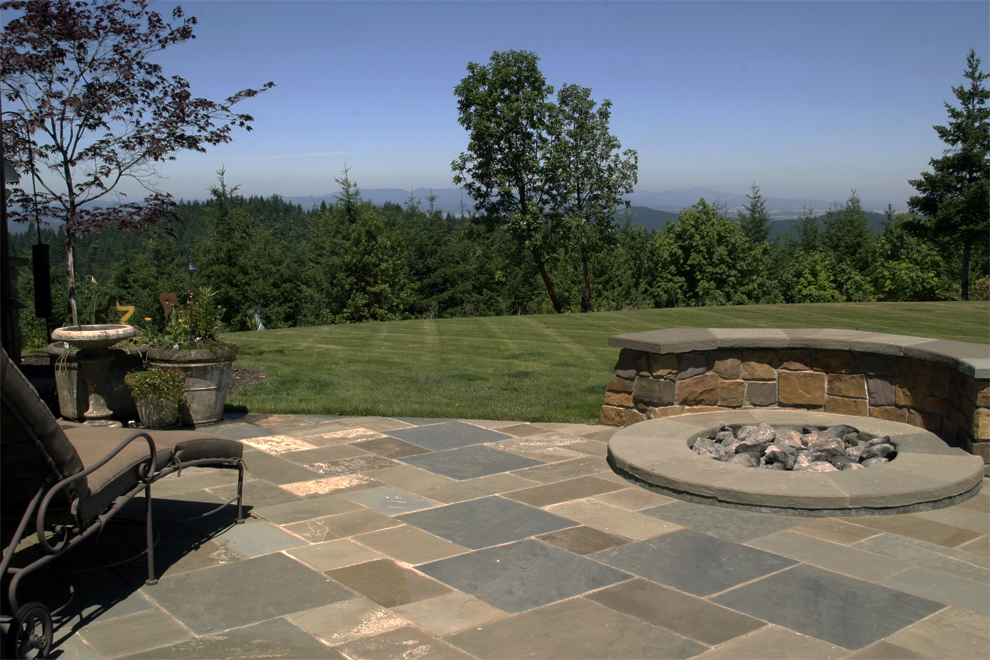
In the market for a new attraction out back without a total overhaul? Landscaping ideas can be as little or as big as your heart (and wallet) desire. If a small addition is all you are looking for, a fire pit may be just what the landscape architect ordered.
Depending on your existing landscape design and the type of project you’re willing to undertake, you may find something as simple as a decorative, wood-fueled fire bowl or something as extravagant as a built-in, propane-fueled fireplace with glistening fire glass. Decide what is right for your residence in Eugene, Oregon.
When deciding what will work best for your setup, there are a few important aspects you’ll want to consider:
First and foremost, your budget. There is no sense it getting all worked up about a particular plan just to determine there’s no way to fund it. Establishing a budget first will help reign in your ideas and ensure you don’t get in over your head. Depending on your plan, you may be able to incorporate phased upgrades, so you don’t need to bear the cost all at once.
Space/location: Whether you have acres of forest and rolling hills, or a contemporary condo downtown with a small patio, there’s surely something to suit your needs. Deciding how much space you’re willing to dedicate and the best locations to work with, will help you hone in on your options. It’s important to consider what purpose you want this fiery addition to serve. Are you the first one to throw a celebratory barbeque when we get three consecutive days of sunshine or do you prefer to cozy up for a quiet night in with someone special?
Fuel Source: Deciding whether you prefer the convenience and clean burn of gas or propane, or you relish the smoky air of a wood fire pit on a cool summer night, can be a tough decision but one that you’ll need to establish early on.
Whatever your decisions may be, now is the time to get that fireball rolling. Long summer days and cool summer nights will be here before you know it!
As winter approaches, it can become a challenge to maintain your garden. Many plants fail to flourish in the onslaught of heavy rains and precipitation, primarily because of excess water and lack of oxygen. While some plants struggle to survive in Eugene’s wet winter climate, others thrive. Here is a list of several plants that perform well in wet winter soil:
The Big Leaf Maple tree is an elegant and stately tree native to the Willamette Valley that provides cool shade in the summer and grows large leaves which can be composted or used to curb weed growth.
Hellebores are beautiful flowers that are able to withstand extreme weather.
Mock Orange is a shrub that supplies food and shelter to birds while also yielding beautiful white flowers.
Tulips can be planted in the fall, as can daffodils and hyacinths. These spring-flowering bulbs are beautiful and capable of withstanding Eugene’s winter climate.
If you grow your own vegetables, fall planting season is also a good time to consider next summer’s harvest (garlic, for example). It is also appropriate to transplant trees and shrubs from your landscape at this time.
The Willamette Valley is rich in color and vegetation as a result of frequent rains and natural underground water springs, but occasionally aspects of this kind of climate can hinder the vitality of a homeowner’s landscape. An abundance of precipitation coupled with an inefficient drainage system will result in soggy lawns and garden beds at best, and in the worst case can result in unhealthy plants, a ruined lawn and a damaged foundation.
Proper exterior drainage diverts water away from the home, yard and landscape, and requires careful evaluation of the site’s natural landscape and climate. In concert with this evaluation, appropriate decisions will be made regarding various drainage options and which of these options are best suited to your home’s landscape design. We invite you to explore a number of drains that can be installed to facilitate proper drainage:
French drains, wrapped in landscape fabric and masked in rock, offer a subtle solution for homes with raised planters.
Area or floor drains are placed in yards with shallow spaces that collect water during heavy rains as a means of preventing mosquito growth and foundation damage.
A gutter with a downspout that drains away from the home and yard is a necessary staple for homeowners who wish to protect their home from interior and exterior water damage.
Foundation drains are a requirement for new construction, but older homes may need to have a foundation drain installed on the edge of or beneath the foundation.
Channel drains protect your lawn and garden from patio runoff and are long channels in a concrete surface that allow water to filter into the pipes below which direct the flow of precipitation away from the home and landscape.
At Lovinger Robertson Landscape Architects, we take even the smallest details into consideration. One of our many priorities is to design a functional drainage system along with a master design plan that together will culminate in a practical and timeless landscape design.